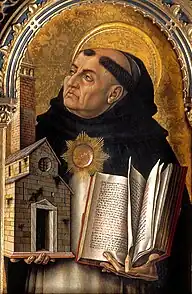Luis de Molina | |
|---|---|
 Portrait of Luis de Molina | |
| Born | 29 September 1535 |
| Died | 12 October 1600 (aged 65) |
| Alma mater | University of Salamanca |
| Era | 16th-century philosophy Second scholasticism |
| Region | Western philosophy |
| School | Molinism School of Salamanca |
Main interests | Contract law Economics Mercantilism |
Notable ideas | Introducing Molinism |
| Part of a series on |
| Catholic philosophy |
|---|
   |
Luis de Molina SJ (29 September 1535 – 12 October 1600) was a Spanish Jesuit priest, theologian and jurist follower of Second scholasticism of the School of Salamanca. A staunch defender of free will in the controversy over human liberty and God's grace. His theology is known as Molinism.
Life
From 1551 to 1562, Molina studied law in Salamanca, philosophy in Alcalá de Henares, and theology in Coimbra. After 1563, he became a professor at the University of Coimbra, and afterward taught at the University of Évora, Portugal. From this post he was called, at the end of twenty years, to the chair of moral theology in Madrid, where he died.[1]
Besides other works he wrote De liberi arbitrii cum gratiae donis, divina praescientia, praedestinatione et reprobatione concordia (4 vols., Lisbon, 1588); a commentary on the first part of the Summa Theologiae of Thomas Aquinas (2 vols., fol., Cuenca, 1593); and a treatise De jure et justitia (6 vols., 1593–1609).
It is to the first of these that his fame is principally due. It was an attempt to reconcile, in words at least, the Augustinian doctrines of predestination and efficacious grace with the new ideals of the Renaissance concerning free will. Assuming that man is free to perform or not to perform any act whatever, Molina maintains that this circumstance renders the grace of God neither unnecessary nor impossible: not impossible, for God never fails to bestow grace upon those who ask it with sincerity; and not unnecessary, for grace, although not an efficient, is still a sufficient cause of salvation (gratia mere sufficiens, "merely sufficient grace"). Nor, in Molina's view, does his doctrine of free will exclude predestination. The omniscient God, by means of His scientia media (the phrase is Molina's invention, though the idea is also to be found in his older contemporary Fonseca), or power of knowing future contingent events, foresees how we shall employ our own free-will and treat his proffered grace, and upon this foreknowledge he can found his predestinating decrees.
These doctrines, which opposed both traditional understanding of Augustinism and Thomism concerning the respective roles of free will and efficacious grace, and the teachings of Martin Luther and John Calvin, excited violent controversy in some quarters, especially on the part of the Dominican Order and of the Jansenists, and at last rendered it necessary for the Pope (Clement VIII) to intervene. At first (1594) he simply enjoined silence on both parties so far as Spain was concerned; but ultimately, in 1598, he appointed the Congregatio de auxiliis Gratiae for the settlement of the dispute, which became more and more a party one. After holding very numerous sessions, the congregation was able to decide nothing, and in 1607 its meetings were suspended by Paul V, who in 1611 prohibited all further discussion of the question de auxiliis and of discussions about efficacious grace, and studious efforts were made to control the publication even of commentaries on Aquinas .
Several regent Masters of the Dominican College of St. Thomas, the future Pontifical University of Saint Thomas Aquinas (Angelicum), were involved in the Molinist controversy. The Dominicans Diego Álvarez (c. 1550–1635), author of the De auxiliis divinae gratiae et humani arbitrii viribus,[2] and Tomás de Lemos (1540–1629) were given the responsibility of representing the Dominican Order in debates before Pope Clement VIII and Pope Paul V.[3]
The Molinist subsequently passed into the Jansenist controversy.
Molina was also the first Jesuit to write at length on economics and contract law.[4] Prior to Molina's time, economic thought was closely tied to Catholic moral theology. Molina was part of an emerging trend which contributed to the separation of analysis of economic activity from theological questions of sin. This trend was a significant step towards the emergence of modern economics with Adam Smith in the 18th century.[5] In his writings on economics, Molina helped further develop a theory of price inflation proposed by Juan de Medina and Martín de Azpilcueta in Salamanca, writing that "[i]n equal circumstances, the more abundant money is in one place, so much less is its value to buy things or to acquire things that are not money."[6]
Molina was among the first people to use discuss the “diamond-water paradox”. Where water is of more abundant and useful than a diamond, the value of the diamond is far greater than the value of water due to its association with a higher social status and scarcity. This paradox arises because the value of a good, in classical economics, is determined by its scarcity and its utility. Many other great thinkers have used the diamond-water paradox to describe how the relative scarcity of a product can determine its price. Overall, the diamond-water paradox challenges classical economic theory and highlights the importance of subjective perceptions of value and scarcity in determining market prices.
In his De jure et Justitia Molina says, “the just price of a pearl, which can be used only to decorate, is higher than the just price of grain, bread, or horses, even if the utility of these things is superior.”
Works
- De liberi arbitrii cum gratiae donis, divina praescientia, praedestinatione et reprobatione concordia, 4 vols., Lisbona, 1588; 2nd ed. Antwerp, 1595.
- De Hispanorum primogeniorum origine ac natura (in Latin). Lugduni: Pedro Landri. 1588.
- De jure et justitia, 6 vols., 1593–1609.
- De iustitia et iure (in Latin). Vol. 1. Coloniae Allobrogum: Marc Michel & C Bousquet. 1733.
- De iustitia et iure (in Latin). Vol. 2. Coloniae Allobrogum: Marc Michel & C Bousquet. 1733.
- De iustitia et iure (in Latin). Vol. 3. Coloniae Allobrogum: Marc Michel & C Bousquet. 1733.
- De iustitia et iure (in Latin). Vol. 4. Coloniae Allobrogum: Marc Michel & C Bousquet. 1733.
- De iustitia et iure (in Latin). Vol. 5. Coloniae Allobrogum: Marc Michel & C Bousquet. 1733.
- Commentaria in primam partem divi Thomae (in Latin) (2 vols., fol. ed.). Cuenca. 1593.
- Commentaria in primam divi Thomae partem (in Latin). Venetiis: Compagnia Minima. 1594.
 De Hispanorum primogeniorum origine ac natura, 1588
De Hispanorum primogeniorum origine ac natura, 1588 De iustitia et iure, 1733
De iustitia et iure, 1733
Notes
- ↑ Luis de Molina, A Treatise on Money Archived 2018-03-03 at the Wayback Machine. CLP Academic, 2015, p.xxiii.
- ↑ "Diego Alvarez". The Original Catholic Encyclopedia. 21 July 2010. Archived from the original on 2012-03-16. Retrieved 9 March 2013.
- ↑ "Lemos "lé-", Tomás de". Enciclopedia Treccani (in Italian). Retrieved 9 March 2013.
- ↑ Luis de Molina, A Treatise on Money Archived 2018-03-03 at the Wayback Machine. CLP Academic, 2015, p.xxv.
- ↑ Luis de Molina A Treatise on Money Archived 2018-03-03 at the Wayback Machine. CLP Academic, 2015, p.xxvi.
- ↑ Luis de Molina, A Treatise on Money Archived 2018-03-03 at the Wayback Machine. CLP Academic, 2015, p.96.
References
- This article incorporates text from a publication now in the public domain: Chisholm, Hugh, ed. (1911). "Molina, Luis". Encyclopædia Britannica. Vol. 18 (11th ed.). Cambridge University Press. p. 667.
- An article by Alfred J. Freddoso on Luis Molina's thoughts.
- Article on Molina from Catholic Encyclopedia (1911)
- Article on Molinism from Catholic Encyclopedia (1911)
- Ulrich L. Lehner (ed.), Die scholastische Theologie im Zeitalter der Gnadenstreitigkeiten (monograph series, first volume: 2007) https://web.archive.org/web/20070812004619/http://www.bautz.de/rfn.html
- Luis de Molina, A Treatise on Money. CLP Academic, 2015.
Further reading
A full account of Molina's theology will be found in Gerhard Schneeman's Entstehung der thomistisch-molinistischen Controverse, published in the Appendices (Nos. 9, 13, 14) to the Jesuit periodical, Stimmen aus Maria-Laach.
- Ernest Renan's article, Les congregations de auxiliis in his Nouvelles études d'histoire religieuse.
- Alonso-Lasheras, Diego. "Luis de Molina's De Iustitia et Iure. Justice as Virtue in an Economic Context", Leiden: Brill 2011.
- Matthias Kaufmann, Alexander Aichele (eds.), A Companion to Luis de Molina, Leiden: Brill 2014.
- MacGregor, Kirk. Luis de Molina: The Life and Theology of the Founder of Middle Knowledge. Grand Rapids: Zondervan 2015. [the first full book on Molina]
- Smith, Gerard (ed.) Jesuit thinkers of the Renaissance, Milwaukee (USA) 1939, pp. 75–132.
- A critical edition of Treatise on Money was translated and published by Christian's Library Press as A Treatise on Money (2015): Luis de Molina, A Treatise on Money Archived 2018-03-03 at the Wayback Machine. CLP Academic, 2015.
External links
- Griffin, Michael V. (2006). "Molina, Luis De (1535–1600)". In M. Borchert, Donald (ed.). The Encyclopedia of Philosophy. Vol. 6. pp. 321–323. Retrieved 16 September 2023.
- Luis de Molina in the Historical Archives of the Pontifical Gregorian University
- On Divine Foreknowledge: Part IV of the Concordia at the Internet Archive (registration required)

